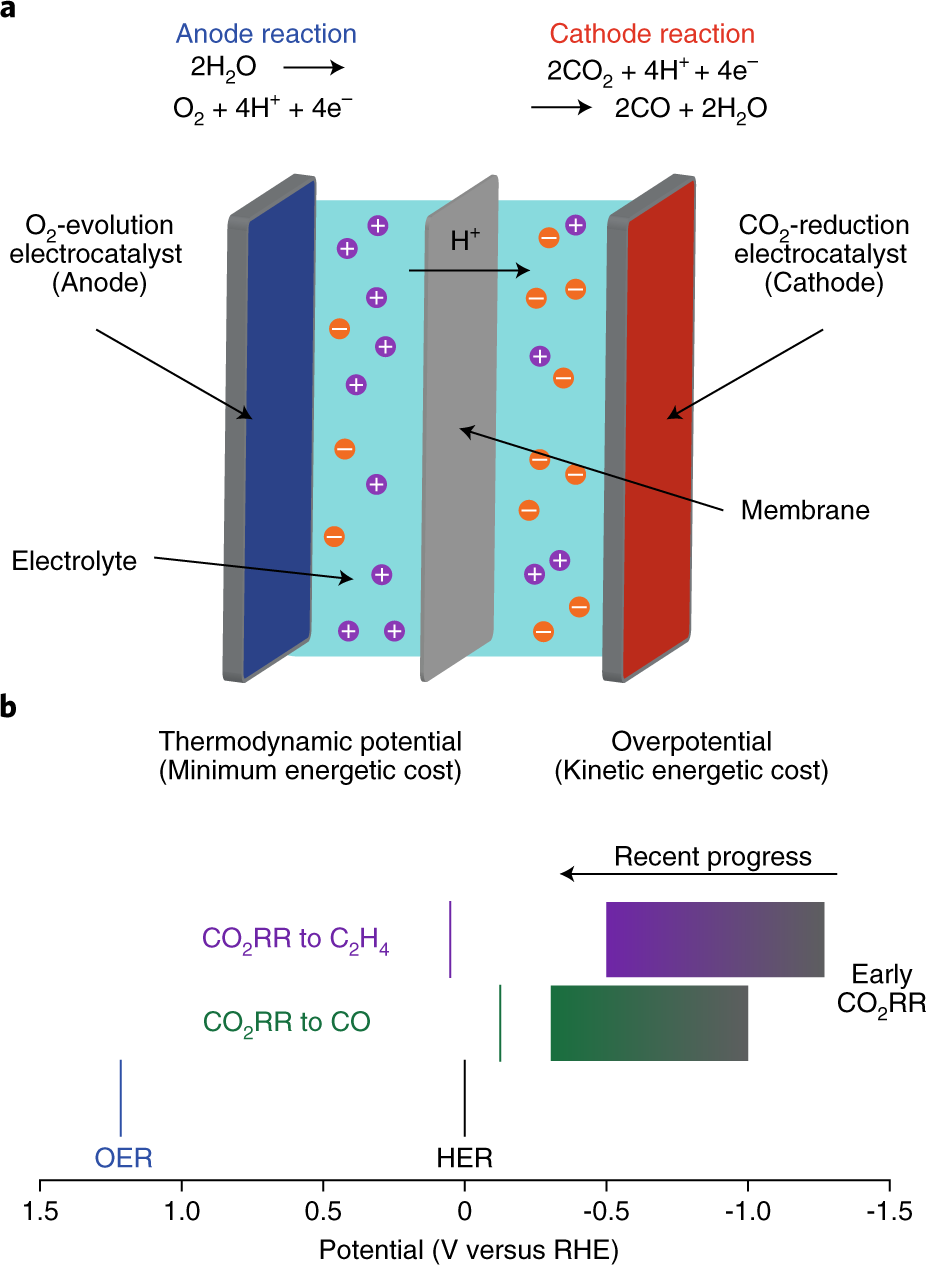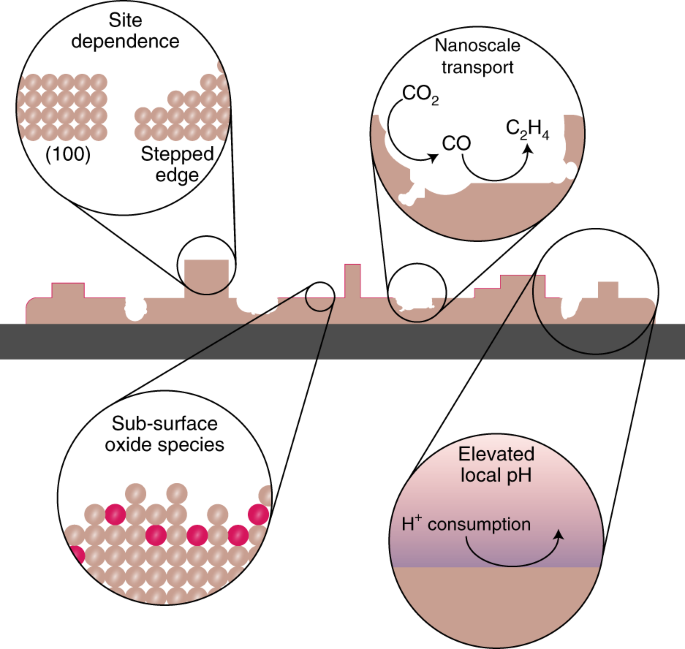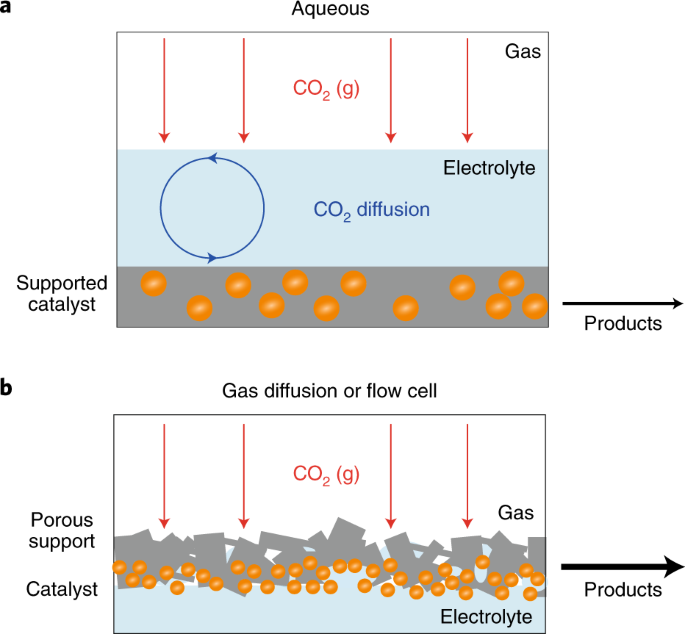Electrochemical CO 2 conversion offers an attractive route for recycling CO 2 with economic and environmental benefits while the catalytic materials and electrode structures still require further improvements for scale-up application. Up to 10 cash back Electrochemical CO 2 reduction reaction CO 2 RR is an attractive pathway for closing the anthropogenic carbon cycle and storing intermittent renewable energy by converting CO 2 to valuable chemicals and fuels.
Designing Materials For Electrochemical Carbon Dioxide Recycling Peidong Yang Group
Electrochemical carbon dioxide reduction to fuels presents one of the great challenges in chemistry.

. Surprisingly we found that 6070 of the ethanol contained 18O which. 2 8 At present modern society relies on coal natural gas and oil to synthesize the fuels and chemicals that. 2Before CO 2 RR tests all the samples were pre-treated.
Alongside the CO 2 activation and reduction process the reduction of bound. Numerous studies have examined the electrochemical reduction of CO COR to oxygenates eg ethanol. Alfaifi 1 Naseem Iqbal 6 Maryam Abdinejad 7 Asif Ali Tahir 8 and Habib Ullah 8 1 Center of.
I electrode design and ii reactor design and system integration. Electrochemical carbon dioxide recycling provides an attractive approach to synthesizing fuels and chemical feedstocks using renewable energy. Recycling Carbon Dioxide Through PEM Electrolysis Subject.
Suliman 1 Bandar Y. A Review article by Mike Ross et al titled Designing Materials for Electrochemical Carbon Dioxide. Herein we present an understanding of trends in electrocatalytic activity for carbon dioxide reduction over different metal catalysts that rationalize a number of experimental observations including the selectivity with respect to the competing hydrogen.
Up to 10 cash back Rational design and synthesis of multimetallic nanostructures NSs are fundamentally important for electrochemical CO2 reduction reaction CO2RR. Recycling is published in Nature Catalysis. The electrochemical activity was tested in a standard three-electrode system with 05 M NaHCO 3 as the electrolyte Supplementary Fig.
On the path to deploying this technology basic and applied scientific hurdles remain. The catalysts must be able to convert CO 2 to other carbon-based products with high activity and selectivity to valuable chemicals. Department of Energy Bioenergy Technologies Office s Engineered Carbon Reduction Listening Day held July 8 2017 in La Jolla CA.
This capability could further decouple CO 2 emissions from economic growth in addition to aiding the mitigation of rising global CO 2 emissions. And De Luna Phil and Li Yifan and Dinh Cao-Thang and Kim Dohyung and Yang Peidong and Sargent Edward H abstractNote Electrochemical carbon dioxide recycling provides an attractive approach to synthesizing fuels and chemical. ThecathodeistheelectrocatalystthatimplementstheCO 2 reduc-tionreactionCO 2 RRTheanodeprovidesasiteforoxidation.
Electrochemical reduction of carbon-dioxidecarbon-monoxide CO2R to fuels and chemicals presents an attractive approach for sustainable chemical synthesis but it also poses a serious challenge in catalysis. Electrocatalytic surface and near-surface engineering ESE has great potential to advance CO 2 reduction reactions CO 2. On the path to deploying this technology basic and applied scientific hurdles remain.
Understanding the key aspects that guide CO2R towards value-added multicarbon C2 products is imperative in designing an efficient catalyst. A Review of Cobalt Based Catalysts for Carbon Dioxide Conversion to Fuels Muhammad Usman 1 Muhammad Humayun 2 Mustapha D. Nanomaterials Review Electrochemical Reduction of CO2.
Eochemical carbon dioxide recycling ElectrochemicalCO 2-recyclingECRsystemsFig1aincludea cathodeananodeaCO 2-containingelectrolyteandamembrane. Articleosti_1601205 title Designing materials for electrochemical carbon dioxide recycling author Ross Michael B. The flow cell is simple and no electrolyte is consumed.
The design of an greenhouse gas emissions will be required by the year 2050 energy-efficient integrated system for capture and conversion in order to stay below a 2 C change in global temperature. Materials could be transformational for mitigating climate change13 Climate models predict that negative andor materials eg hydrocarbons. Integrating catalytic design with mechanistic understanding yields scientific insights and progresses the technology towards.
None have considered the possibility that oxygen in the product might arise from water rather than from CO. Electrochemical reduction reaction of CO 2 CO 2 RR is a promising technology for alleviating the global warming caused by the emission of CO 2This technology however is still in the stage of finding efficient catalysts. Integrating catalytic design with mechanistic understanding yields scientific insights and progresses the technology towards.
Recycling carbon dioxide into fuels and chemicals remains a grand challenge of science and engineering. Ross 12 Phil De Luna 23 Yifan Li 14 Cao-Thang Dinh 25 Dohyung Kim 6. To test this assumption C16O reduction was performed in H218O electrolyte.
The production of highly reduced carbon compounds beyond CO and formate such as hydrocarbon and oxygenate products. This capability could further decouple CO 2 emissions from economic growth in addition to aiding the mitigation of rising global CO 2 emissions. Designing materials for electrochemical carbon dioxide recycling MB Ross P De Luna Y Li CT Dinh D Kim P Yang EH Sargent Nature Catalysis 2 8 648-658 2019.
Membrane electrode assembly electrolysis can significantly promote the catalytic efficiency. Designing Materials for Electrochemical Carbon Dioxide Recycling. Herein a multi-step seed-mediated growth method is applied to synthesize asymmetric AuAgCu heterostructures using Au nanobipyramids as nucleation seeds in which their.
Recycling Carbon Dioxide Through PEM Electrolysis Presentation from the US. Currently we are working on developing high performance electrochemical devices for the conversion of carbon dioxide into valuable chemicals such as ethylene ethanol and propanol. Recycling carbon dioxide into fuels and chemicals remains a grand challenge of science and engineering.
Designing materials for electrochemical carbon dioxide recycling Competition with dihydrogen evolution. Electrochemical carbon dioxide recycling provides an attractive approach to synthesizing fuels and chemical feedstocks using renewable energy. Because electrocatalysis occurs at solidliquid and solidliquidgaseous.
Scopus 23 Google Scholar. Designing materials for electrochemical carbon dioxide r ecycling Michael B. To achieve these goals we focus on two major areas.
Garba 3 Latif Ullah 4 Zonish Zeb 5 Aasif Helal 1 Munzir H. Electrochemical carbon dioxide recycling provides an attractive approach to synthesizing fuels and chemical feedstocks using renewable energy. Indium nitride is used as efficient catalyst for electrochemical reduction of carbon dioxide to formate.
Interfacial interactions at the surface.

Pdf Designing Materials For Electrochemical Carbon Dioxide Recycling

Designing Materials For Electrochemical Carbon Dioxide Recycling Nature Catalysis

Designing Materials For Electrochemical Carbon Dioxide Recycling Nature Catalysis

Electrolytic Cell Design For Electrochemical Co2 Reduction Sciencedirect

Designing Materials For Electrochemical Carbon Dioxide Recycling Nature Catalysis

Designing Materials For Electrochemical Carbon Dioxide Recycling Nature Catalysis

Designing Materials For Electrochemical Carbon Dioxide Recycling Nature Catalysis

Designing Materials For Electrochemical Carbon Dioxide Recycling Nature Catalysis
0 comments
Post a Comment